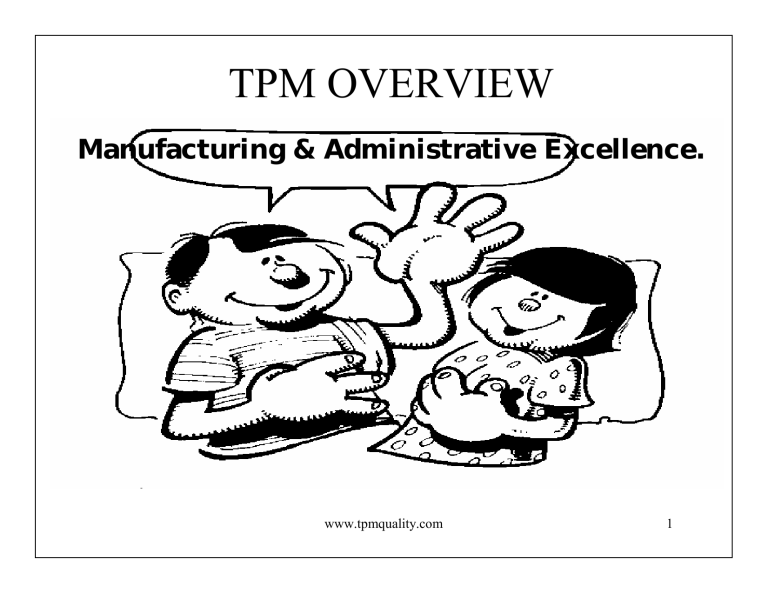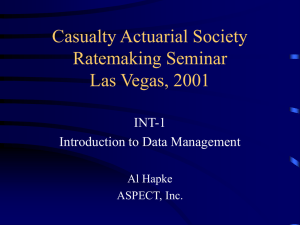
TPM OVERVIEW Manufacturing & Administrative Excellence. www.tpmquality.com 1 Background of TPM • Main manufacturing excellence approach of Toyota and other excellent Japanese companies since the 70’s. • TPM is foundation for JIT, FA, Poka Yoke, Lean Manufacturing, Zero Defects. • TPM Reference Standard - JIPM (Japan Institute of Plant Maintenance) • Comes from the best of Japanese Industrial Excellence and evolved from the heat of the continuing Energy Crisis and Globalization challenges to achieve More with Less. www.tpmquality.com 2 Executive Overview Of 1. Autonomous Maintenance 2. Equipment Improvement 3. Planned Maintenance 4. Quality Maintenance 5. Office TPM www.tpmquality.com 3 Logic of AM Steps Step 7 Steps 4,5,6 Flattened Improve Worker Knowhow to maintain Equipment through Structured Specific Skills. Organization. Steps 1,2,3 Improve the Equipment User -Friendliness www.tpmquality.com 4 AM STANDARDS Step # Step Goal Standards Step 1 Restoration => 85% repair rate Step 2 Eliminate Sources of Contamination =>70% successful effort Step 3 Improve Equipment Accessibility =>70% successful effort Step 4 Initial Maintenance Standards > 50% sudden b/d reduction Step 5 General Inspection Skills > 90% sudden b/d reduction Step 6 Autonomous Inspection > 95% sudden b/d reduction Step 7 Organise and manage workplace www.tpmquality.com TBD by management 5 Goal of Planned Maintenance. Achieve “ZERO EQUIPMENT BREAKDOWNS” by implementing systems of “parts replacement before failure” through TBM and CBM. Equipment Total Maintenance Standards Production Autonomous Maintenance System. P.M. Standards General Inspection Stds. + Annual Maintenance Plans www.tpmquality.com 6 Planned Maintenance Activities: o Support Autonomous Maintenance Activities by technical support, breakdown analysis and demarcation between Production & P.M. Systems. o P-M Analysis for chronic breakdowns. o Time Based Maintenance items o Condition Based Maintenance items. o Spares Mgtm & Maintenance Day Practice. www.tpmquality.com 7 Role of Plant EI Team Achieve systematic breakthroughs in equipments’ 6 BIG LOSSES and establish Standards for Basic Machine Conditions. The Basic Machine Conditions are: 1. Cleaning Standards. 2. Lubrication Standards. 3. Bolt-tightening Standards. www.tpmquality.com 8 Equipment 6 Big Losses (Focus is at the Bottleneck processes.) 1. Breakdown Losses 2. Speed Losses. 3. Setup Losses. 4. Defect Losses. 5. Start-up or Yield Losses 6. Minor Stoppages Losses www.tpmquality.com 9 Severity Of Equipment 6 Big Losses LOSSES LEVEL 1 LEVEL 1 Maint MAINT LEVEL 1.Breakdown • • • losses • Have chronic B/Ds B/d Repair time PM time. >20% deviation of service life range. Root-cause s of breakdown not clear. • LEVEL 2 • • • • • 2.Setup Losses Incomplete setup documentation. • Setup times variation >30%. 3.Minor Stoppages • No awareness/data. • • Equipment specs not clear. No settings documented by different packages/ machine models & types. • • Nothing done about chronic losses. No results from previous actions • 4.Speed Losses 5. Defect & Startup Losses • • • • • • • Only spontaneous breakdowns. B/d Repair time = PM time. Within parts service life span. Root-causes of B/Ds are clear and addressed. Complete set-up documentation On-line and off-line setups are defined. SetupTime variation < 15% Data on frequency, location of minor stoppages. Root-causes are clear Settings documented by package / machine type. < 5% variation between same type machines Chronic defects are quantified by type, frequency and volume. Root causes for problems are identified and understood. LEVEL 3 • • • • • • Time-based component maint. system. D/Trepair time < PM time B/d downtime < 1% Service life of components => upper range of specs. Successful efforts to convert on-line to off-line setups All adjustments are fully clarified and standardized. •. Reduced 1/20th of current minor •lrvrl.Root-causes of stoppages are clear and countermeasures in place. • Countermeasures for rootcauses of speed losses implemented. • Revised settings with notes on quality and accuracy impact. • < 2% speed loss. • Countermeasures implemented effective for early in-process detection of defects. • Q-components identified and effects on quality are clear. www.tpmquality.com LEVEL 4 • • • • • • • • • • • • Condition-based maint system Maint staff do only PM. AM do D/T repairs < at 0.1% of DT level. Clear improvement in MTBF Optimal set-ups under 10 mins. 1st time set-up produce good parts. No need to adjust any further. Zero minor stoppages. Operates at designed speed or above. Zero Speed losses M-Q relationship established. Regular audit of Qcomponents Loss due to quality defects is < 0.1% 10 Sporadic & Chronic Problems Why-Why Analysis. P-M Analysis. For problems with clear and assignable causes. For problems with clear causes & no effective countermeasures www.tpmquality.com 11 Why-Why Analysis & P-M Analysis • Used with other data analysis or data collection tools. • Emphasize on logical reasoning to fully understand the whole chain of cause-effects so as to devise holistic multiple solutions. • All defects, breakdowns, accidents and work – problems are result of an error by Man which is the Root Cause. • Problems are traced to all the 4Ms • Solution Sustained by linked to the TPM systems. www.tpmquality.com 12 Quality Maintenance: is activities to set equipment conditions, based on the basic concept of maintaining perfect equipment to maintain perfect quality of processed goods. The machine conditions (Q-Components) are checked and measured in time-series to verify that measured values are within standard values to prevent defects. The transition of measured values is watched to predict possibilities of defects occurring and to take countermeasures beforehand. www.tpmquality.com 13 Role of Plant TPM-QM Achieve “ZERO DEFECT” by identifying all the upstream factors of Equipment causes of defects and implementing fool-proofing techniques to eliminate man and materials-caused defects. 1. Identify all the Q-components 2. Implement fool-proofing techniques to prevent man and materials-caused defects. 3. Eliminate all Chronic defects. www.tpmquality.com 14 ABOUT OFFICE TPM • Is a structured 5S program using Why-Why Analysis as a problem-solving tool. • Has similar Autonomous Maintenance 5 Steps • Improves “CRITICAL FUNCTIONS” of Ware-house, Storage Place, administrative areas’ through work-flow studies. • Areas contributing to OEE losses are selected for Kai’zen activities. www.tpmquality.com 15 The 5S step-by-step program. 1 - Cleaning & Restoration. Thoroughly restore & clean. Motivation through participation. 2 - Eliminate Stains, Mixed, Study Root Causes of Dirt, Mixing, Contamination. Loss, damage and take actions. 3 - Improve Accessibility. Achieve 1 minute accessibility time for documents + parts. Implement stock-management-at 1 glance. 4 – Standardization & Control of Work. Achieve a problem-free work flow in stock inventory, data availability. 5 - Self Management Self Managing Work Teams. www.tpmquality.com 16




